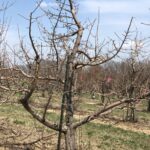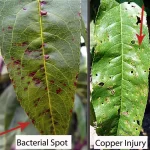As of right now, we simply do not know if we will have crops from our woody fruit producing plants, from apples to grapes to peaches. Remember: The ability to produce fruit is determined in the spring with flower development. Any factor, whether abiotic, insect or pathogen, that interferes with flower development will impact fruit set. Nothing affects flower development and fruit set like a spring freeze, with flower damage resulting when a critical temperature threshold (32 degrees F or less) is reached. The incidence and severity of this damage to flower buds is often variable even when critical temperature thresholds are reached (or exceeded!). The reasons for damage variability are due in part to the fact that:
- 1. Different species and cultivars of trees have different requisite chilling hours (hours needed to break dormancy). Apples require 800 and 1750 hours of temperatures below 45 degrees to break dormancy; peaches require 300-1000 chilling hours.
- 2. The actual number of chilling hours achieved that season. For a map of this, see https://mrcc.purdue.edu/VIP/indexChillHours2
- Individual trees of all cultivars vary in their sensitivity to budbreak based upon predisposing stresses (excess crop in previous year, root rot, inappropriate late season fertilization, etc);
- Each bud varies in its dormancy/hardening off.
That’s a lot of variables, and although it helps in our understanding of why freeze damage occurs, it doesn’t provide us with a lot of actionable strategies to manage to prevent this problem, besides good plant health management, especially proactive thinning and avoiding excess N fertilizer.
Uneven bud break is affecting some of the apple varieties at Meigs (Fig. 1). This is usually associated with apples that grow in areas with mild winters, like the one we just had. Apple trees in warmer climates often demonstrate uneven bud breaking and bloom times. With the combination of early bloom, coupled with trees exhibiting everything from silver tip to pink, the question must be asked: To spray, or not to spray? This is quickly followed by what do you decide to spray?
No one should be surprised that my vote is to spray. Depending upon timing, light freezes are helpful in thinning heavy crops, and it won’t be until May when we will know if we have a crop. In examining leaf litter, pseudothecia are already developing and preparing to shoot ascospores. Although this is early in the season, spores will infect bud scales just like they infect leaves, and in this case, may infect both at the same time! There may be only 5% of the pseudothecia producing mature ascospores, but infection can and will occur. And each one of those ascospores can produce a lesion with almost 100,000 more conidia (asexual spores). A few ounces of prevention now will yield tons of cure later!
Based upon the presence of so many shoots at pink, copper is not an option. With future rains in the forecast, captozeb (captan+mancozeb) is probably your best bet, until more green tissue is there. If the weather stays cool, include Vanguard and Scala early in the rotation. Save FRAC 3:DMI fungicide application (Inspire, Indar, Rally, etc.), FRAC 11:strobilurin (Flint, Sovran), FRAC 7+11: premix (Merivon, Luna Sensation, Pristine), or FRAC 7:SDHI (Fontelis, Aprovia) until more green tissue is present—this will be a more strategic use for your systemic fungicides.
Despite the potential or real loss of crop, it is imperative to maintain a least a minimum spray program to protect future harvests. Failure to do so will result in defoliated trees that fail to produce next year or may not survive the next winter, or break bud earlier than usual. Normally, the greatest risk of scab would be right now, from pink to bloom. However, nothing is normal about this year (or maybe global weirding is our new normal!). For these reasons, I am recommending:
- EDBC fungicide (3 lb/acre) program through bloom.
- If the crop is lost, alternate with copper or sulfur from second cover on to remain under label limits. Remember to stay within the 21.0 lb/acre/season limit for your EBDCs., like mancozeb I like the EBDCs as they also protect against bitter rot, black rot and white rot. Use this schedule if cedar-apple rust is a particular problem.
- Alternatively, Captan can be used earlier in the season for better scab control instead of the EBDCs. Keep in mind that captan provides no control of rust or powdery mildew. If these appear to be a problem, applications of FRAC 3: DMI fungicides (Rally, Indar, Cevya, etc.) in rotation should take care of scab, rust and powdery mildew.
- NOTE: Do not use Captan in combination with or closely following or in alternation with wettable sulfur products, or oil. Sulfur sensitive varieties of apples such as Red Delicious, Staymen, and Baldwin, can suffer severe injury and defoliation. Captan 50 WP has a 64 lb limit per acre per year; Captan 80WDG has a 40lb per acre per year limit.
One other option that can be used is copper (0.2 – 0.6 lb metallic copper per acre based on tree row volume) + sulfur (6-30 lb/acre depending on brand/formulation) every 10-14 days between now until the first week in June, depending upon weather conditions after a crop is lost. Suggested sulfur formulations include Thiolux, Microthiol Disperss, or Microfine Wettable sulfur. This spray program protects against scab and mildew, and slightly against rust. Remember, copper can russet fruit, and should not be used if you want to use your crop for anything except cider. Do not use sulfur if temperatures are going to exceed 90 degrees F, or drying conditions are extremely poor. Do not use sulfur or copper within two weeks of an oil application. Neither of these programs is going to provide complete scab control but should reduce leaf infections. Organic trials in both Michigan and North Carolina regularly apply 6 lbs of sulfur per treatment without any reported phytotoxicity due to temperature.
Managing Diseases on Stone Fruits:
Late spring freezes and severe winter cold regularly causes stone fruit crop losses to approach 100%. In 2024, stone fruit have already faced temperatures below -11 in the north, which may have already eliminated a fruit crop. With this level of irregular cropping, disease management must focus on protecting foliage to ensure a good potential crop for next year, while reducing overwintering spore loads. Copper is fairly phytotoxic to peaches and should be avoided (Fig. 2). A great article about bacterial spot and copper injury can be found at: https://onfruit.ca/2020/06/15/see-spots-run-bacterial-spot-and-peach-scab-season-is-here/
- Bravo is a low(er) cost alternative should disease pressure become high, but fruit is absent. Use at 1 pint/100 gal
- Captan at the 1.3 lb/ 100 gallon rate should sufficiently control brown rot twig blight, scab on peaches and cherry leaf spot.
- If the season is excessively wet, higher rates of captan or Bravo may be required.
- Captan will not control powdery mildew.
- Wettable sulfur at the 6 lb per 100 gallon rate is probably the least expensive material you can use and provides excellent control of powdery mildew of all stone fruit
- Wettable sulfur should aid in controlling brown rot twig blight, and peach scab but keep expectations tempered.
- Flame Out (Oxytetracycline) or Mycoshield should be used to control bacterial spot on peaches particularly if the weather is wet in late June and July.
As always, forewarned is forearmed! We can’t control the weather, but we can control how we manage the trees, with an eye for future crops. For more information, see: BP-179 Disease Management for Fruit Trees After Crop Loss at https://www.extension.purdue.edu/extmedia/BP/BP-179-W.pdf
- Figure 1. Uneven bud break is often associated with trees grown in climates with milder winters resulting in asynchronous phenology of many fruit trees. Note the variation from silver to tight cluster. Photo by Janna Beckerman.
- Figure 2. Copper injury on peaches can be mistaken for bacterial spot. Photo by Wendy McFadden-Smith.

